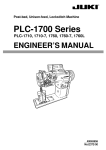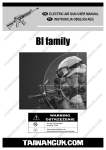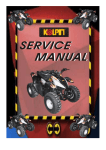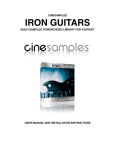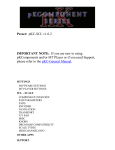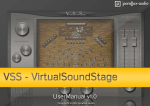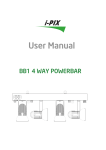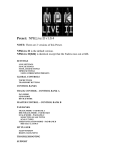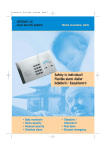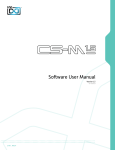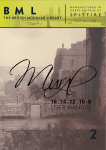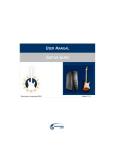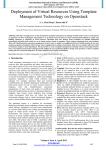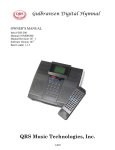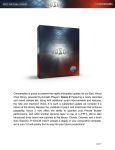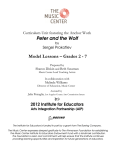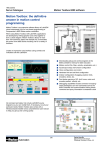Download the User Manual
Transcript
CINESAMPLES HOLLYWOODWINDS USER MANUAL AND USER AGREEMENT Cinesamples HWW User Manual - 1 of 10 (version 3) Copyright cinesamples, LLC CONTENTS: Concepts Solutions Scale Tunings The Tempo Engine Table of Patches The Piano Style Patches The Textures The GUI The User Agreement ............................. ............................. ............................. ............................. ............................. ............................. ............................. ............................. ............................. 3 4 4 5 5 6 8 9 10 THIS LIBRARY REQUIRES YOU TO HAVE A COPY OF NATIVE INSTRUMENTS KONTAKT (NOT INCLUDED) Kontakt 2.2.4+ or Kontakt 3.5=/+ CINESAMPLES TEAM: Created/Produced by: Michael Barry and Michael Patti Mixed by: Programmed by: Tim Starnes Greg Schlaepfer Research Consultant: Composition Team: Jason Graves Alex Pfeffer and Jason Graves Special Thanks to: Greg Shlaepfer, Kolby Allen, John M. Davis, Jason Graves, Chad Seiter, Lynne Patti, Alex Pffefer, Jan Petrov, Corey Wallace Cinesamples HWW User Manual - 2 of 10 (version 3) Copyright cinesamples, LLC Concepts behind HOLLYWOODWINDS The music libraries created by Cinesamples have been specifically created to pick up where existent libraries leave off. After analyzing the products available for use by the modern multi-media composer, we specifically noticed a lack of non-ethnic woodwinds, especially in tutti or ensemble form. Upon surveying the current woodwind libraries available, we noticed first that the current woodwind libraries focus on solo instruments. In general, solo sampled instruments lack the power to cut through more active orchestration or higher dynamic intensity. Secondly, solo woodwind instruments do not blend as naturally when forming a tutti thus making it nearly impossible to achieve a passible tutti woodwind sound. Thirdly, having the full woodwind choir loaded as separate stems is a relatively expensive task in terms of polyphony and ram usage. Fourthly, creating fast moving passages with fluidity can be a very time consuming task and often involves manipulating the libraries very radically. In conclusion, to the sample-based composer, there is little incentive to struggle through the process of synthestrating woodwinds when the final product take a large chunk of the deadline time and only sounds mediocre at best. In many beloved modern scores, there is a certain professional craftsmanship heard in the woodwind section (particularly true when analyzed from a synthestrators’ point of view). From a musical point of view the woodwind section has much to offer the track, especially when the orchestration begin to get more active. In times like these the woodwinds shine, demonstrating their abilities in fast runs, trills, turns, etc. Hearing a purely sample based composition that includes inherit elements of classic John Williams-type orchestration is a eye opening experience. After doing some research we noticed that there are a few private libraries around which have supplemented very nicely for those who were able to write in this fashion. The lack in the proper samples to compose in this style has lead to an understandable departure from composing in this style at all. Since the woodwinds occupy an equal rank and importance in this style of composing, not having them present leaves a part of the musical landscape noticeably empty. Cinesamples HWW User Manual - 3 of 10 (version 3) Copyright cinesamples, LLC HOLLYWOODWINDS is Born A classic technique for synthestrating true-to-life cues is to mix live elements with samples. Live elements not only add life to a track but they also add credibility to the samples and the composition as a whole. Enter: HOLLYWOODWINDS. Having a phrase library with an identical sounding patch library (same mix, same room, same players, specialized orchestration) can lead to some tremendous results in the composer’s studio. The scales, rips and textures used in HWW were carefully selected to cover as much ground as possible without becoming overly unique or too focused. For example, a two octave run starting on the fifth and ending on the fifth is entirely useful in many applications. This is especially useful considering that with HWW your tempo can sync to your sequencer. The phrase patches should be considered a good starting point to fill in the core of the track. You can also use the patches to decorate and fill in more customized lines. Scale Tunings During preproduction we did our homework by studying a ton of cinematic scores and chatting with composers/orchestrators. We did this in order to make sure that HWW would have a classic “Hollywood” sound. To this end, we created a varied choice of tunings and shapes. For example, if you needed a scale in Ab Major you would have 10 shapes from which to choose- some 1 octave up, some 1 octave down, some 2 octaves up then down etc. (see addendum). The F Natural Minor scale can also be accessed to increase your choices. For the scales, you will find the following tunings: Major Natural Minor Harmonic Minor Chromatic Octatonic Whole Tone See addendum for more information on scale shapes. Cinesamples HWW User Manual - 4 of 10 (version 3) Copyright cinesamples, LLC Cinesamples Intelligent Time Engine (C.I.T.E) - The Tempo Locking Engine (80 BPM - 230 BPM) (Used only by patches listed as Time Engine patches) The tempo locking engine uses a combination of innovative scripting plus automatic multi sample selection to achieve sync. Each sample was recorded at 2 tempi. The selected patch will take the tempo you’ve set and decide which of the appropriate samples to use. From there. the patch will make the proper micro adjustments to lock tempo with your sequencer or your manual entry. Be sure to quantize your midi to ensure sync. Table of Patches Each patch comes as Stage Mics Only, Close Mics only, with the default set at Stage and Close Mics. Each patch additionally comes as a Kontakt 2 or Kontakt 3 patch. Keyboard Patches: -Chordal Tremolos -Major and Minor Traids -Octaves -Tutti -Unison Tremolos Scales and Rips: -Atonal Rips -Chromatic Scales* -Harmonic Minor Scales* -Major Scales*+ -Natural Minor Scales*+ -Octatonic Scales* -Tonal Rips -Whole Tone Scales* ^IMPORTANT NOTE: Any patches using C.I.T.E must be used exclusively with the version of Kontakt it was created for, otherwise there will be synchronization issues. This difference is caused by a change on Native Instrument’s end which made Kontakt 3 different from 2. Textures and FX: -FX 5th Chord -FX Cluster Chords and Flutters -FX Pitch Bending FX -FX Random Note Staccato Patterns -TEX Chord Trill Quarter Notes -TEX Inspiring 1 (Duplet)* -TEX Inspiring 2 (Triplet)* -TEX Inspiring 3 (Classical, Triplet)* -TEX Light Hearted Motif* -TEX Lydian Thirds* -TEX Marching Patterns* -TEX Octaves Repeating (Duplet)* -TEX Octaves Repeating (Triplet)* -TEX Oom Pah Major Minor* -TEX Repeating Major and Minor Chords* * These patches use the C.I.T.E (Cinesamples Intelligent Time Engine) which will allow automatic tempo synchronization in your sequencer. + Since the spelling of Major and Natural Minor scales is harmonically identical they can be both be used for either scale type. Cinesamples HWW User Manual - 5 of 10 (version 3) Copyright cinesamples, LLC THE 3 KEYBOARD PATCHES These patches are mapped per pitch to the keyboard like a piano would be, except they have a few extra twists which are explained below. The Sustain Pedal (CC 64), Expression (CC 11) and Modulation (CC 1) are all active on these patches. The mod wheel will control the volume of the attack articulation be it a staccato attack articulation or a legato attack articulation. To trigger staccato samples one would play staccato on the keyboard while having the modwheel up (and no sustain pedal). While the sustain pedal is active the mod wheel will control the volume of the legato attack samples instead of the staccato. Using a combination of the modwheel and the sustain pedal (or absence thereof) can lead to a realistic representation of a phrase. You can also activate the legato switch on the Kontakt interface for futher assistance playing monophonic lines. CC 11 Expression will apply a filter change to further simulate expression and detail in playing. THE OCTAVES PATCH RANGE: C3 - Bb4 (C4) In film music, the octave is arguably the most important interval for the woodwind choir. Therefore, the octaves patch is one of the most powerful components of HollyWoodWinds. The large majority of fast moving woodwind writing relies on stacking octaves in order to get the needed power and necessary doubles. This patch contains the instruments which cover the soprano range and higher voiced as follows: Root (C3): +1 Octave (C4): +2 Octave (C5): (Oboe 3, Clarinet in Bb 2, Clarinet in Bb3) (Flute 2, Flute 3, Oboe 1, Oboe 2, Clarinet in Eb 1) (Piccolo) In this feature, when you strike a single note you will trigger a three octave stacked voicing which is common in film scoring. This type of voicing remains consistent throughout the entire patch, ending only where certain instruments need to drop out due to range limitations. Since the high flutes and piccolo are the core of this octave stacked voicing, the patch has been conceived to cover their power range, stopping only at their highest playable pitches. What is really important about this patch is that it is intelligent. If you play upward, all the instruments go up, if you play downward all the instruments go down. This is different from traditional ensemble patches where the only way to create a fluid ensemble patch over many octaves is to have instruments drop in and out. With HWW and the octaves patch, you get no sudden orchestrated range issues created artificially by the library producers. There’s also no artificial doubling (playing a three octave staccato on a normal tutti patch you might end triggering the clarinets three times, the piccolo twice, the oboes twice etc.). Additionally, this concept is used in creating the scales so the integration is seamless between the patch and the phrase. Cinesamples HWW User Manual - 6 of 10 (version 3) Copyright cinesamples, LLC THE TRIADS PATCH (MAJOR AND MINOR) Another fantastic use of the woodwind section comes through stacking closedvoiced triads over two octaves. The triads patch uses a similar concept as the octaves patch but addresses this different voicing. You hear this technique used very effectively specifically by John Williams in his greatest action scores (Star Wars, Indiana Jones, Harry Potter etc..). Going back even further, you can hear a Prokofiev/Stavinsky-like quality to these triads, especially when used in a non-diatonic fashion. The triads are very useful by themselves as a woodwind statement, but also when doubling brass triads or sweeping string lines. The voicing is as follows: Root Third Fifth Octave Tenth Twelfth C3: E3: G3: C4: E4: G4: Clarinet 3, Oboe 3 Clarinet 2, Oboe 2, Clarinet 1, Oboe 1 Flute 3 Flute 2 Piccolo 1 Again, this voicing remains consistent until the flutes exceed their range. This patch is excellent at adding vibrant color to your track and might even take you in a direction you did not intend while sketching. THE TUTTI PATCH This is a typical ensemble patch, using the entire choir (Bassoons, Clarinets, Oboes, Flutes, Piccolo) spread out over many octaves. We used some tricks to smooth out the ranges caused by instruments coming in and out. This patch can really serve many obvious functions especially when combined with the rest of the library. THE TREMELOS/TRILLS PATCHES Half Step - From Unison/Octave Whole Step - From Unsion/Octave Major Major Minor Minor Chord Chord Chord Chord - Whole Half Whole Half (C (C (C (C major major minor minor to to to to D Major) Db Major) D minor) Db minor) Cinesamples HWW User Manual - 7 of 10 (version 3) Copyright cinesamples, LLC You will find the necessary half and whole step trills here with a small twist. We decided to once again employ the ensemble method. So, a half step trill on a G will not just trigger one G to one Ab but rather a properly voiced ensemble trill covering several octaves and several appropriate Gs to Abs. The same holds true for the other voicings, using well-orchestrated ensemble trills instead of monophonic unison trills. The chordal trills are unique as they are pre-orchestrated chordal trills triggered by a single keyboard stroke. THE TEXTURES (TONAL) We decided to include some commonly used woodwind settings which we refer to as “textures”. These textures incorporate the CITE and will sync to tempi as needed. The textures are fantastically useful for quickly adding life to a track with a stroke of one key. Our intention was to take the idea of mixing phrases with samples one step further by implementing full section phrases into the library. Repeating triplet octaves for the scherzo, pulsating chords while the strings soar, or marching an accompaniment for the brass theme all demonstrate fantastic uses of the winds in relation to the orchestra. With HWW, they can all be easily triggered via one key. They will automatically loop as needed until the key is released. The addendum shows piano reductions of what is included. (RIPS) Included are a wide variety of both tonal and atonal rips. The tonal rips focus on an ending pitch and are played live with no time engine. There are variations in the notes leading up to the final pitch which can be used to suggest different tunings (major, minor, diminished etc...). These are useful for hits and supporting brass staccatos. The atonal rips are available for both long and short hits, with some using just the treble instruments, some the full ensemble, some 3 piccolos etc. They cover a lot of ground and can be used in a variety of orchestral situations. (ATONAL) No modern library would be complete without exploring the 20th century techniques used so effectively in horror/trailer music. Included in this patch are many examples of clusters, staccato patterns, rising and Cinesamples HWW User Manual - 8 of 10 (version 3) Copyright cinesamples, LLC falling textures and bending notes. They are looped where possible, however some were impossible to loop due to their random nature. TEMPO: MIXING: EQ: VELOCITY: 80-230, Will automatically sync move knob to custom or choose pull down menu options Stage Mics (default), Close Mics move knobs to custom or choose pull down menu options A basic 3 knob EQ preset or equalizer presets Velocity/volume scaling NOTATION VIEW: Kontakt 3 Patches only (live changing), (only scales) Cinesamples HWW User Manual - 9 of 10 (version 3) Copyright cinesamples, LLC HOLLYWOODWINDS LICENSE AGREEMENT Please carefully read the following terms which detail the license agreement. To install this library you must agree to the following terms which will become active immediately upon installation. Your license will be terminated upon violation of any of the conditions of the following agreement. User is provided with a singular commercial license for use in commercial recordings. This license entitles this one individual to install and use HOLLYWOODWINDS on up to three computers or samplers provided they are the sole owner of these devices. Cinesamples also grants the user access to simultaneously use the provided library on any of these three systems at one time. Remember that this library and its contents will remain, at all times, the copyrighted property of Cinesamples and that this library is only licensed to the said user. Certain scripting techniques used in this library may be protected by patents in this company’s name. In no situation may any of the content of this library be resold or repackaged in ANY form. This library may not be distributed by any method or device other then Cinesamples or an authorized Cinesamples dealer. Upon online checkout Cinesamples will provide you with a personal serial number which will be used to activate your installation application. If you purchased this product in boxed form you will be sent your serial # via email from Cinesamples shortly after submitting your identification # to our authorization email account. During the installation process this number will be embedded into all files used by the library. It is important to keep your serial number and files secure at all times as the content of your library will be directly traceable to you. This license may not be transferred to any other user. It is the sole responsibility and risk of the user to engage in this license agreement. Cinesamples will not be responsible for any damages or losses caused by the use or misuse of this library in any form. All violations or acts of piracy will be swiftly prosecuted to the fullest extent of the law. Allies of our company are everywhere, speak every language, and constantly monitor all channels of distribution. Help us help you! By agreeing to these terms we promise to continue to release future reasonably priced, niche libraries. If you have witnessed any violation of these terms please contact customer support at: [email protected] Cinesamples HWW User Manual - 10 of 10 (version 3) Copyright cinesamples, LLC











